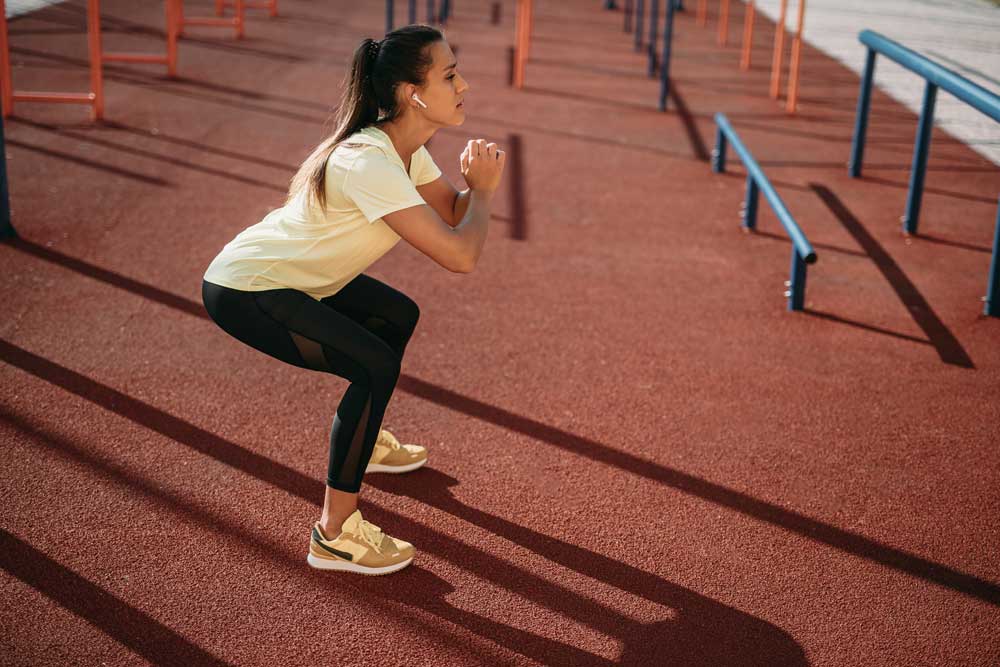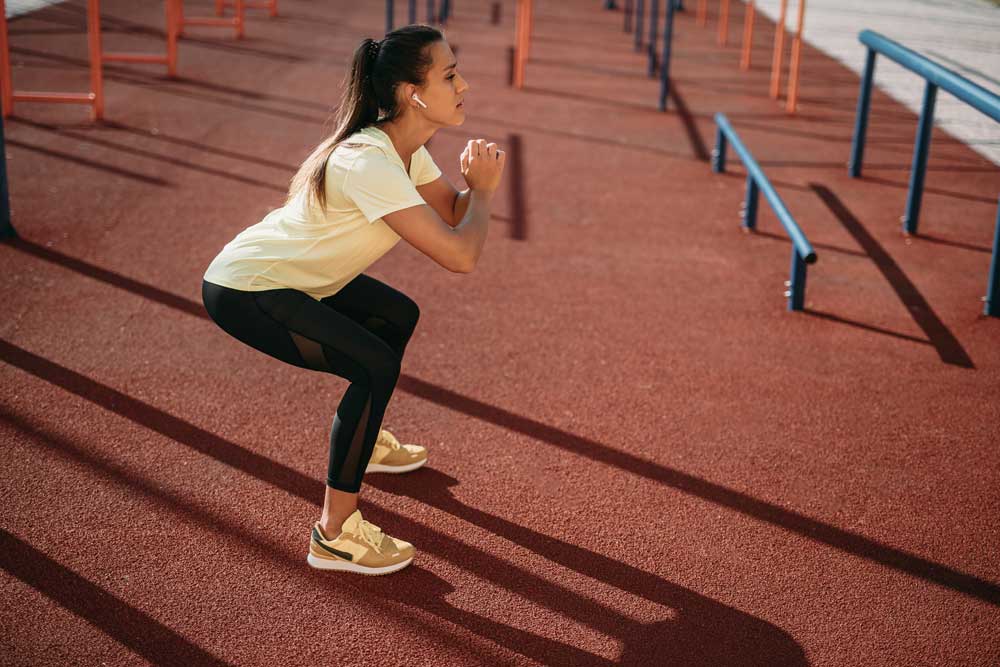The Perfect Air Squat – Great Squat Mechanics for Life

One of the first movements a quality coach assesses for a new personal training client is the most basic movement in all of human physiology: the air squat.

Get Good Squat Mechanics for Life
The squat is a full-body functional movement that translates to necessary, everyday activities: sitting on a toilet or in a chair, squatting down to stoke a bonfire or grab a can of beans from the bottom shelf, or get eye-level with your cranky child.
Watch a baby or toddler squat to check something out on the ground and you’ll see all you need to see—our bodies were built for this movement. It’s as natural as walking. The tissues in our ankles, knees, and hips are designed to flex and extend in harmony with one another to give us a tiny edge on gravity.
The air squat can tell a coach a lot about your fitness level. Every elite strength athlete can perform an air squat while it’s common for beginners to struggle. Mobility restrictions and injuries can also keep you from engaging all the musculature needed to squat with toddler-proficiency.
The hard truth is: you shouldn’t be squatting with weight if you can’t squat without it first.
Everyone should be able to squat well into old age. Think of how much more independent the 90-year-old who can still do an air squat is compared to their stiff friend at the nursing home who needs help getting up and down. If health is wealth, then a healthy air squat is a fully-funded 401K.
Check out our primer on air squats and practice them like your life depends on it.







DOWNLOAD
trainheroic’s
free APP
How to do the perfect Air Squat
Points of Performance
Squat positioning can vary slightly based on an athlete’s morphology. How long your femurs are compared to your torso compared to how your joints fit together—those kinds of factors count for small variations in your stance versus your buddy next to you. You probably won’t squat exactly the same way, but there are some universal truths.
Stance
Build your perfect air squat from the floor up. Start with your feet anywhere from hip to shoulder-width apart. Depending on your body, some people prefer a narrower or slightly wider stance. As long as you can complete the movement in an effective way, try not to get caught up in the nuances. Get a feel for your perfect stance by trying both shoulder and hip width.
Toes forward or toes out?
Dr. Aaron Horschig of Squat U covers this topic so well.
Your feet are the foundation of your squat and everything else. The direction they take is going to determine how your form looks all the way up the chain of your body. Whether you squat with your toes forward or slightly turned out is largely a result of your anatomy, mobility, and motor control.
Beginners should try both with the goal being balance and proper positioning for the rest of your squat. The key point for balance is this: your weight should be distributed evenly from the ball of your foot to your heel with a slight preference for the weight in your heel.
Spine & pelvis: don’t dump the bucket
If you’ve ever overheard a CrossFit kids class, you might’ve caught the instructor repeating a cue like, “don’t dump your bucket!” This is a reference to the pelvic “bowl” and the kid’s ability to control their lower spine. Squatting with a neutral spine is key. You want to maintain your lumbar curve without arching (anterior pelvic tilt) or tucking (posterior pelvic tilt) your pelvis.
Pelvic control can be a pain to fix when you’ve been squatting poorly for years, so teaching kids to keep their bucket stable can help them avoid back pain in the future. But if you have trouble with pelvic stability, it’s never too late to drill corrective exercises. Being aware of your pelvis makes a huge difference for all of your weight training exercises.
Hip Hinge
Once you’ve got your stance, feet, core, and pelvis in check, unlock your hips to sit down and back into a squat. Use your arms to counterbalance by extending them forward or slightly up. Keep your chest up and your knees in line with your toes.
Whatever your stance, your knees should always track over your toes (or to the outer edge). If your knees cave in or flare out, it’s a red flag that something is up with your stance.
The length of your legs or your ankle mobility can allow your knees to come past your toes when squatting. As long as you’re balanced in your feet, that’s fine. Contrary to popular misinformation, it doesn’t matter so much how far your knees go over your toes as long as they’re tracking in line with them.
Depth
During warmups and as standard practice, you should be able to squat as deep as possible with proper form and spine (and bucket!) control. A full-depth squat (aka. ATG or “ass to grass”) means the angle of the athletes thighs are past parallel to the floor.
It may take time and commitment to working on your mobility to achieve a deep and stable squat. Many beginners start by squatting to a target like a box or medicine ball in order to get a feel for how deep they should aim to sit.
For workouts with a lot of fast air squats programmed, you only need to hit past parallel before you recover.
Recover
From the bottom of your squat, reverse the movement by driving through the floor and using your legs and glutes to stand up. It helps to think of squeezing your glutes and pushing your hips forward as you come up to standing. Those particular cues are especially helpful once there’s a heavy load on your back.
The Marketplace: Shop Expert Programming from Real Coaches
Sometimes all you need to reach your destination on your fitness journey is an expert guide. We’ve got you covered.
The TrainHeroic marketplace is the only place to purchase programming from the World’s best coaches, delivered through the immersive training experience of the TrainHeroic app.
Browse from thousands of programs for any goal and every type of athlete.
Or, join a monthly programming membership to connect with a real coach and community of athletes training just like you. Try any programming subscription free for 7 days.


Whatever the problem is, the answer is to squat
Remember: just because the air squat is unweighted doesn’t mean it should always feel easy. Every large muscle in your body is working to hold tension in the right places. A solid air squat recruits your entire posterior chain (the largest muscles in your body) and forces you to stabilize your midline, moving from your core to your extremities.
Squatting is essential across all strength sports—Olympic weightlifting, powerlifting, bodybuilding, CrossFit. It’s also an essential, natural movement for babies and grannies alike. We want everyone to be able to squat well for the rest of their lives, and it all starts with the air squat.



Lily frei
Lily is TrainHeroic’s Marketing Content Creator and a CF-L1 with an English background. She was a successful freelance marketer for the functional fitness industry until being scooped up by TrainHeroic. An uncommon combo of bookish, artsy word-nerd and lifelong athlete, Lily is passionately devoted to weightlifting, CrossFit, yoga, dance, and aerial acrobatics. Find her showcasing her artist-athlete hobbies on IG @lilylectric.


Join the community
Sign up for the latest training news and updates from TrainHeroic



About TrainHeroic
Support
Made with love, sweat, protein isolate and hard work in Denver, CO
© 2021 TrainHeroic, Inc. All rights reserved.







